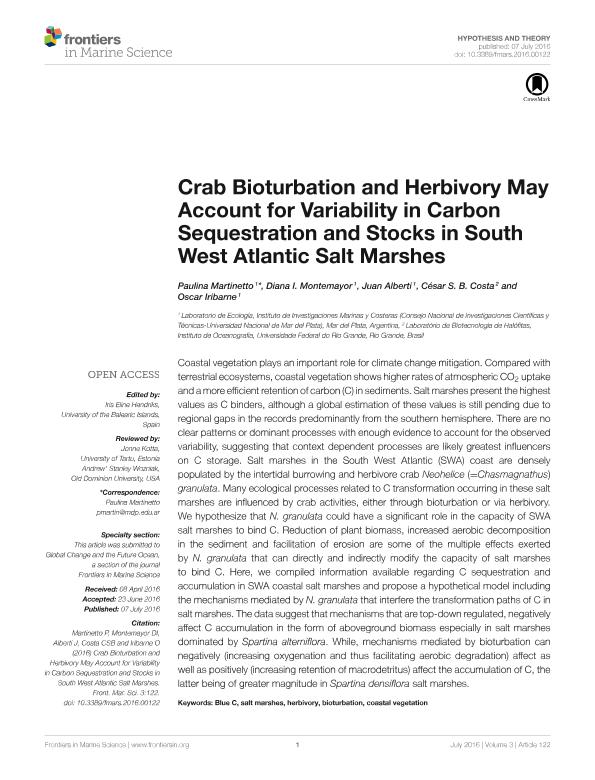Mostrar el registro sencillo del ítem
dc.contributor.author
Martinetto, Paulina Maria del Rosario

dc.contributor.author
Montemayor Borsinger, Diana Ireri

dc.contributor.author
Alberti, Juan

dc.contributor.author
Costa, César S. B.
dc.contributor.author
Iribarne, Oscar Osvaldo

dc.date.available
2018-08-16T12:53:40Z
dc.date.issued
2016-02
dc.identifier.citation
Martinetto, Paulina Maria del Rosario; Montemayor Borsinger, Diana Ireri; Alberti, Juan; Costa, César S. B.; Iribarne, Oscar Osvaldo; Crab bioturbation and herbivory may account for variability in carbon sequestration and stocks in south west atlantic salt marshes; Frontiers Research Foundation; Frontiers in Marine Science; 3; JUL; 2-2016; 122-126
dc.identifier.issn
2296-7745
dc.identifier.uri
http://hdl.handle.net/11336/55825
dc.description.abstract
Coastal vegetation plays an important role for climate change mitigation. Compared with terrestrial ecosystems, coastal vegetation shows higher rates of atmospheric CO2 uptake and a more efficient retention of carbon (C) in sediments. Salt marshes present the highest values as C binders, although a global estimation of these values is still pending due to regional gaps in the records predominantly from the southern hemisphere. There are no clear patterns or dominant processes with enough evidence to account for the observed variability, suggesting that context dependent processes are likely greatest influencers on C storage. Salt marshes in the South West Atlantic (SWA) coast are densely populated by the intertidal burrowing and herbivore crab Neohelice (= Chasmagnathus) granulata. Many ecological processes related to C transformation occurring in these salt marshes are influenced by crab activities, either through bioturbation or via herbivory. We hypothesize that N. granulata could have a significant role in the capacity of SWA salt marshes to bind C. Reduction of plant biomass, increased aerobic decomposition in the sediment and facilitation of erosion are some of the multiple effects exerted by N. granulata that can directly and indirectly modify the capacity of salt marshes to bind C. Here, we compiled information available regarding C sequestration and accumulation in SWA coastal salt marshes and propose a hypothetical model including the mechanisms mediated by N. granulata that interfere the transformation paths of C in salt marshes. The data suggest that mechanisms that are top-down regulated, negatively affect C accumulation in the form of aboveground biomass especially in salt marshes dominated by Spartina alterniflora. While, mechanisms mediated by bioturbation can negatively (increasing oxygenation and thus facilitating aerobic degradation) affect as well as positively (increasing retention of macrodetritus) affect the accumulation of C, the latter being of greater magnitude in Spartina densiflora salt marshes.
dc.format
application/pdf
dc.language.iso
eng
dc.publisher
Frontiers Research Foundation

dc.rights
info:eu-repo/semantics/openAccess
dc.rights.uri
https://creativecommons.org/licenses/by-nc-sa/2.5/ar/
dc.subject
Bioturbation
dc.subject
Blue C
dc.subject
Coastal Vegetation
dc.subject
Herbivory
dc.subject
Salt Marshes
dc.subject.classification
Otras Ciencias Biológicas

dc.subject.classification
Ciencias Biológicas

dc.subject.classification
CIENCIAS NATURALES Y EXACTAS

dc.title
Crab bioturbation and herbivory may account for variability in carbon sequestration and stocks in south west atlantic salt marshes
dc.type
info:eu-repo/semantics/article
dc.type
info:ar-repo/semantics/artículo
dc.type
info:eu-repo/semantics/publishedVersion
dc.date.updated
2018-08-15T14:22:35Z
dc.journal.volume
3
dc.journal.number
JUL
dc.journal.pagination
122-126
dc.journal.pais
Suiza

dc.description.fil
Fil: Martinetto, Paulina Maria del Rosario. Consejo Nacional de Investigaciones Científicas y Técnicas. Centro Científico Tecnológico Conicet - Mar del Plata. Instituto de Investigaciones Marinas y Costeras. Universidad Nacional de Mar del Plata. Facultad de Ciencia Exactas y Naturales. Instituto de Investigaciones Marinas y Costeras; Argentina
dc.description.fil
Fil: Montemayor Borsinger, Diana Ireri. Consejo Nacional de Investigaciones Científicas y Técnicas. Centro Científico Tecnológico Conicet - Mar del Plata. Instituto de Investigaciones Marinas y Costeras. Universidad Nacional de Mar del Plata. Facultad de Ciencia Exactas y Naturales. Instituto de Investigaciones Marinas y Costeras; Argentina
dc.description.fil
Fil: Alberti, Juan. Consejo Nacional de Investigaciones Científicas y Técnicas. Centro Científico Tecnológico Conicet - Mar del Plata. Instituto de Investigaciones Marinas y Costeras. Universidad Nacional de Mar del Plata. Facultad de Ciencia Exactas y Naturales. Instituto de Investigaciones Marinas y Costeras; Argentina
dc.description.fil
Fil: Costa, César S. B.. Universidade Federal do Rio Grande do Norte; Brasil
dc.description.fil
Fil: Iribarne, Oscar Osvaldo. Consejo Nacional de Investigaciones Científicas y Técnicas. Centro Científico Tecnológico Conicet - Mar del Plata. Instituto de Investigaciones Marinas y Costeras. Universidad Nacional de Mar del Plata. Facultad de Ciencia Exactas y Naturales. Instituto de Investigaciones Marinas y Costeras; Argentina
dc.journal.title
Frontiers in Marine Science
dc.relation.alternativeid
info:eu-repo/semantics/altIdentifier/doi/http://dx.doi.org/10.3389/fmars.2016.00122
dc.relation.alternativeid
info:eu-repo/semantics/altIdentifier/url/https://www.frontiersin.org/articles/10.3389/fmars.2016.00122/full
Archivos asociados
